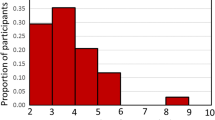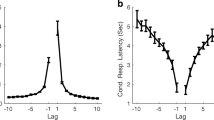Abstract
Recall is inversely related to the number of items sharing a cue. The limiting case of unique cue-target relationships supports extremely high levels of recall, particularly when the cue is self-generated. This fact is incongruous with the importance assigned to the construct of organization in memory theory. Further, self-generated unique cue-target relationships tend to be idiosyncratic, implying that the power of unique cues should be limited to cases of self-cued memory. The experiments presented here suggest a role for organization that reconciles the fact of unique cue effectiveness with the importance of organization to memory. Two new findings are reported: Unique cue production enhances target encoding; and general cues can access particular encodings. The data are further tribute to the importance of simultaneous organizational and distinctive processing and recommend a new perspective on the function of organization in memory.
Article PDF
Similar content being viewed by others
References
Battig, W. F., & Montague, W. E. (1969). Category norms for verbal items in 56 categories: A replication and extension of the Connecticut category norms.Journal of Experimental Psychology Monographs,80, (3, Pt. 2).
Craik, F. I. M. (1979). Levels of processing: Overview and closing comments. In L. S. Cermak & F. I. M. Craik (Eds.),Levels of processing in human memory (pp. 447–461). Hillsdale, NJ: Erlbaum.
Craik, F. I. M., &Jacoby, L. L. (1979). Elaboration and distinctiveness in episodic memory. In L. Nilsson (Ed.),Perspectives on memory research: Essays in honor of Uppsala University’s 500th anniversary (pp. 145–166). Hillsdale, NJ: Erlbaum.
Craik, F. I. M., &Lockhart, R. S. (1972). Levels of processing: A framework for memory research.Journal of Verbal Learning & Verbal Behavior,11, 671–684.
Einstein, G. O., &Hunt, R. R. (1980). Levels of processing and organization: Additive effects of individual-item and relational processing.Journal of Experimental Psychology: Human Learning & Memory,6, 588–598.
Eysenck, M. W. (1979). Depth, elaboration, and distinctiveness. In L. S. Cermak & F. I. M. Craik (Eds.),Levels of processing in human memory (pp. 89–118). Hillsdale, NJ: Erlbaum.
Harris, G., Upfold, D., &Begg, I. (1982). On the role of the speaker’s expectations in interpersonal communication.Journal of Verbal Learning & Verbal Behavior,19, 597–607.
Humphreys, M. S., Wiles, J., &Bain, J. D. (1993). Memory retrieval with two cues: Thinking of intersecting sets. In D. E. Meyer & S. Kornblum (Eds.),Attention and performance XIV: A silver jubilee (pp. 489–507). Hillsdale, NJ: Erlbaum.
Hunt, R. R., &Einstein, G. O. (1981). Relational and item-specific information in memory.Journal of Verbal Learning & Verbal Behavior,20, 497–514.
Hunt, R. R., &McDaniel, M. A. (1993). The enigma of organization and distinctiveness.Journal of Memory & Language,32, 421–445.
Hunt, R. R., &Seta, C. E. (1984). Category size effects in recall: The roles of individual item and relational information.Journal of Experimental Psychology: Learning, Memory, & Cognition,10, 454–464.
Kelly, R. E. S. (1993).Good cues gone bad: Self-generated distinctive cues lose their effectiveness in the absence of explicit recall instructions. Unpublished master’s thesis, University of North Carolina, Greensboro.
Lockhart, R. S., Craik, F. I. M., &Jacoby, L. L. (1976). Depth of processing, recognition and recall. In J. Brown (Ed.),Recall and recognition (pp. 75–102). New York: Wiley.
Mäntylä, T. (1986). Optimizing cue effectiveness: Recall of 500 and 600 incidentally learned words.Journal of Experimental Psychology: Learning, Memory, & Cognition,12, 66–71.
Mäntylä, T., &Nilsson, L. G. (1983). Are my cues better than your cues?Scandinavian Journal of Psychology,24, 303–312.
Mäntylä, T., &Nilsson, L. G. (1988). Cue distinctiveness and forgetting: Effectiveness of self-generated cues in delayed recall.Journal of Experimental Psychology: Learning, Memory, & Cognition,14, 502–509.
Medin, D. L., Goldstone, R. L., &Genter, D. (1993). Respects for similarity.Psychological Review,100, 254–278.
Moscovitch, M., &Craik, F. I. M. (1976). Depth of processing, retrieval cues, and uniqueness of encoding as factors in recall.Journal of Verbal Learning & Verbal Behavior,15, 447–458.
Rubin, D. C., &Wallace, W. T. (1989). Rhyme and reason: Analyses of dual retrieval cues.Journal of Experimental Psychology: Learning, Memory, & Cognition,15, 698–709.
Stein, B. (1977). The effects of cue-target uniqueness on cued recall performance.Memory & Cognition,5, 319–322.
Tulving, E. (1983).Elements of episodic memory. Oxford: Oxford University Press, Clarendon Press.
Tulving, E., &Pearlstone, Z. (1966). Availability versus accessibility of information in memory for words.Journal of Verbal Learning & Verbal Behavior,5, 381–391.
Watkins, O. C., &Watkins, M. J. (1975). Buildup of proactive inhibition as a cue-overload effect.Journal of Experimental Psychology: Human Learning & Memory,104, 442–452.
Author information
Authors and Affiliations
Corresponding author
Additional information
This research was supported by a grant from NICHHD (No. HD25587). G. Craik, R. Guttentag, T. Mäntylä, D. Nelson, and D. Rubin provided constructive criticism of a previous version of the manuscript.
Rights and permissions
About this article
Cite this article
Hunt, R.R., Smith, R.E. Accessing the particular from the general: The power of distinctiveness in the context of organization. Mem Cogn 24, 217–225 (1996). https://doi.org/10.3758/BF03200882
Received:
Accepted:
Issue Date:
DOI: https://doi.org/10.3758/BF03200882




